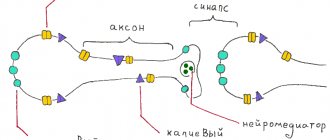Full text of the article:
Attitudes towards smoking have changed over the centuries.
There were periods of popularity for chewing tobacco and cigars, then cigarettes appeared. Until people knew about nicotine addiction, smoking bans weren't as strict, and people smoked literally everywhere. A few decades ago, smoking was fashionable, so among the smokers there were many schoolchildren who tried to assert themselves among their peers in this way. Fortunately, smoking has now gone out of fashion, giving way to a craving for a healthy lifestyle. However, overcoming cigarette addiction is not easy for many. It’s not for nothing that doctors call it addiction. Often people decide to quit smoking, but after a while they relapse due to stress or for the sake of habit. But if you are seriously thinking about how to stop smoking forever
, then we are ready to help.
What does a person expect when he quits smoking?
The man smoked for many years. Of course, he already understood that smoking is a bad habit. And then the doctor said that if you don’t quit, your heart will not hold up or your lungs will fail, or the implant cannot be placed. And so the man decided that it was time to seriously quit smoking.
The person understands that it may not be easy at first. But, after all, he stops constantly poisoning his body. And the body, in the end, must respond with gratitude. A person expects easier breathing, a lift in mood, and a surge of strength.
How to quit smoking on your own: advice from a psychologist
When a person just starts smoking, it seems to him that he can quit at any moment. But there comes a moment when he decides to refuse, but he doesn’t succeed. Family psychologist Irina Kutyanova told how to overcome a bad habit and maintain your health.
“I want to be like everyone else”
A Muscovite came to the family home with a complaint that her son started smoking at the age of 13. One day, a teenager was smoking with friends in the courtyard of the house, and they were noticed by a police patrol. As a result, the student ended up at a meeting of the Commission on Minors' Affairs and the Protection of Their Rights.
After this, the teenager agreed to consult with a psychologist. It turned out that the boy started smoking in the company of his peers because he didn’t want to be a black sheep - he wanted to appear more mature and be liked by the girls in his class.
After several classes aimed at increasing self-esteem, the boy gave up cigarettes. His peers began to treat him with more respect than before, because he was able to defeat himself.
We are working on ourselves
The psychologist provides life hacks that will help those who have long wanted to quit smoking, but don’t know where to start:
- It is important to find the meaning for why you want to quit smoking: for the sake of your health, loved ones, self-esteem. There can be several meanings. To begin with, you can make a list, then prioritize what is important first, what is second, and so on. You can draw it up together with a psychologist. The point of quitting smoking must outweigh any positive benefits associated with smoking. Every time you want to take a puff, it is important to imagine an image of why you are giving up smoking. Gradually the craving for smoking will fade away.
Calculate how much you spend on cigarettes per day, per week, per month and per year. Think about what you could buy for yourself with the money you save. Some people will be able to buy good jeans, while others will be able to buy a laptop. Think about how smoking affects your health. Do you look and feel better or worse than six months or a year ago? Look at your photos now and before you started smoking: has anything changed in your appearance, do you like your reflection?
- There are different strategies for quitting smoking. For example, for some people it is enough to immediately make a decision and never return to a bad habit. Others find it more comfortable to quit smoking by gradually reducing the number of smoke breaks or cigarettes smoked; for others, it is important to have cigarettes with them “just in case,” but not touch them. You can try different strategies, remember which one suits you best in other life situations - gradual change or radical methods. The most important thing is not to delay the implementation of the solution for a long time. If you decide, it is important to start acting on the same day.
Replacing the smoking ritual with other rituals. For example, instead of cigarettes, when it's time for a smoke break, you can chew gum or mint-flavored chewing candy. By replacing one action with another, we gradually weaken the power of the ritual.
- It is important to realize what needs smoking satisfies: the need for relaxation, relieving emotional stress, or others. These needs need to be replaced with safer methods. For example, if the reason for smoking was the need to relax, then start doing yoga, meditation, and breathing relaxation techniques.
The “clean hands” rule says: anyone who decides to quit smoking should not pick up cigarettes. After all, if you don’t take them, you won’t be able to smoke them. This rule is taken from the 12-step program for getting rid of any addiction. And smoking is also one of its types.
- List of triggers. It is important to think and analyze what circumstances and situations in the past led to the resumption of smoking. Perhaps it is stress and conflict in the family or at work. Or maybe your friend lit a cigarette in your presence and you couldn’t resist. It is important to make a list of triggers that lead to a relapse. For each risky situation, it is important to come up with several options for action in order to remain faithful to your decision. This list can be compiled with a specialist. For example, if you were socializing with colleagues in a smoking room, stop visiting it. If your friend or acquaintance actively smokes and invites you to smoke, it is important to tell him about your intention to quit. If this does not stop him, then you need to stop communicating until you are indifferent to other people’s offers to smoke.
Preparations containing nicotine, patches, tablets, will initially help relieve tension and replenish the deficiency of nicotinic acid in the body. It is important to coordinate the course of nicotine therapy with your doctor so as not to overdo it. It is also necessary to understand that addiction to nicotine is formed at the personal level, so the use of patches and tablets is not enough to overcome nicotine addiction.
- Support Group. It is important to find a person or group that will motivate, support and encourage you. If something doesn't work out, lead by example. This person could be a family member, a psychologist, or just an acquaintance who also wants to quit smoking. You can find forums on the Internet where people with similar problems gather and support each other.
- Emotions and health maintenance. In the first time after stopping smoking, irritability increases in the absence of cigarettes. This is normal and will go away after some time. It is important to encourage yourself, praise each time you refrain from smoking, and be more lenient towards yourself and your loved ones. During this period, provide yourself with a balanced diet, plenty of fluids, and moderate exercise to reduce stress and prevent weight gain. Make a “joy list”: what makes you happy now or brought positive emotions in the past. Maybe you remember a dream you wanted to achieve but kept putting off. If you start a new business or project at the same time as stopping smoking, it will help distract you and form new behavioral patterns to replace outdated ones.
Help here
If you or your children are faced with a smoking problem, you can contact psychologists and specialists in the capital’s family centers for qualified help. For your convenience, there is a portal “My Family Center”. Psychologists will help you understand the reasons that led to the development of a bad habit and find the most optimal way to change behavior. Every visitor to the site can use a map of family and childhood support organizations. When you select the required area on the map, the nearest organizations with detailed contact information are displayed.
Source
Press service of the Department of Labor and Social Protection of the Population of Moscow
What usually happens and how does a person break down?
Usually a person lasts two days, three days, a week. There is no improvement. Or rather, it's getting worse and worse. And the point is not even that you want to smoke. Life just ends. The person can't do anything. He cannot work, cannot rest, cannot communicate with loved ones. Life loses its meaning. He wanted to become healthy, but he becomes completely sick. Can't sleep. Can't eat. Everything hurts. And the person begins to think that such a refusal to smoke means that it is harmful to his body. And sooner or later he smokes a “saving” cigarette and starts smoking again.
Did you inject yourself and forget?
Of the medicinal methods of treatment today, the highest percentage of cure is provided by the so-called Swiss method, which is used in clinics specializing in the treatment of tobacco addiction. Before starting treatment, the patient undergoes a mini medical examination: a consultation with a therapist, a neurologist and an ophthalmologist, and he is also given an ECG.
After the examination, the doctor will select the composition and dosage of the drugs. Then a test injection is performed to exclude individual intolerance, and if everything is normal, the main injection is performed. Then the patient sleeps for 10–12 hours - during this time the “adjustment” of receptors sensitive to nicotine occurs.
Everything seemed fine. But the method has contraindications - glaucoma, epilepsy, prostate adenoma and chronic diseases in the acute stage. The second disadvantage is the high cost of treatment: about 40,000 rubles, and this is not affordable for everyone.
The mechanism of addiction and smoker delusion
Why does a smoking person reach for a cigarette?
Taking out a cigarette causes a feeling of emotional or physical discomfort. Without a cigarette, it is impossible to concentrate or relax while resting, or fall asleep at night. I smoked my usual cigarette and everything fell into place.
Thus, in the smoker's mind, a cigarette is associated with pleasure or useful medicine.
Scary secret for smoker No. 1
In fact, a cigarette not only gives a short-term effect of relieving discomfort, but, most importantly, creates delayed discomfort itself.
A terrible secret for smokers No. 2
The smoker's brain does not in any way connect the state of delayed discomfort with the effects of cigarettes.
Moreover, the brain will always find a rational explanation for discomfort that is not related to cigarettes. A person is sure that the bad thing is due to specific life circumstances: accumulated fatigue, natural tightness in communication, or another rational explanation for the discomfort that prompts him to smoke.
This is the mechanism of addiction.
The brain begins to deceive a person just to force him to do the target action - smoke a cigarette and get another dose of nicotine.
Now you can understand why it is difficult for a person to quit smoking. His own brain, included in the mechanism of addiction, actually goes out of control and is constantly looking for “rational” reasons why he should smoke. The brain, knowing you very well, will definitely find this reason.
Nuances of refusal for pregnant women
It is very risky to use methods of nicotine replacement therapy (both pharmaceutical and folk remedies) in pregnant women: nicotine penetrates the placenta, has a very negative effect on the fetus’s body, on the course of periods of its development, and affects the growth and development of the child after birth.
It should also be remembered that the use of medicinal plants during pregnancy is risky. First of all, infusions, decoctions, tinctures do not have a standardized dosage: the same herb collected in different places can have a stronger or weaker effect. This is either dangerous - half a glass of immortelle decoction with an increased concentration of active substances can cause bleeding, or it is ineffective - then the point of using herbal medicine is lost.
The hormonal background of a pregnant woman contributes to sentimentality, tearfulness, and weakness. This is what you should “play” on - to convince the woman of the dangers of smoking at this time, to convincingly prove the harm that nicotine brings to the fetus and child subsequently. Your loved ones may have to control every cigarette, but this is worth doing for the health of the mother and child.
And yet, during this important, often difficult period, it is better to avoid home methods of treating tobacco smoking: seeing a doctor will be more effective and safer.
What happens if a person quits smoking?
Chart of changes in a smoker's condition when quitting cigarettes
The blue line shows the change in a person's condition while he was smoking. Discomfort makes you smoke a cigarette. The condition improves, and then gradually worsens again - the line drops below zero. And an hour later the person again compensates for the discomfort with a new cigarette. It turns out a sinusoid.
And so the man quit smoking.
At first he is full of self-confidence and expects to improve in a couple of days (blue dotted line).
But very quickly the state of discomfort begins to prevail (red line). There is no improvement, as we said. And even if it comes, it is replaced by an even deeper crisis.
The brain, deceived by addiction, finds a reason why it needs to start smoking again (on the graph there is a flash of breakdown in crisis 3).
Maybe just try to smoke less?
If you are addicted to nicotine, you simply will not be able to do this and will soon return to your dose. Quitting smoking is harder in the short term, but easier in the long term. Even if you are one of those people who has been smoking less than half a pack a day intermittently for many years (for example, you may not smoke during pregnancy), it still seriously increases your risk of cardiovascular disease and cancer.
Cardiologists will help you check your cardiovascular system.
How to withstand the withdrawal period and not break down?
Two powerful tips:
By understanding the mechanism of how addiction works, it will be much easier for you to endure the crises of the withdrawal period. But we will offer 2 more powerful tips
Imagine your addiction as someone unpleasant.
For example, a very unpleasant slug that controls you with invisible threads. And in the most difficult moments, fight this unpleasant guy, prove that you are stronger!
Keep an anti-addiction diary
Turn your despair into an entry in this journal.
Keeping a diary of the withdrawal period allows you to:
- do not fall into the trap of “rationalization of consciousness” - substituting reasons for why you want to smoke;
- record the dynamics of the state during the period of withdrawal, realize when the deepest hole will be overcome and improvement will begin;
- count how many days you have left to endure.
Why do some people start smoking again many months after quitting?
What is triggered here is not a drug addiction to nicotine (remember, withdrawal even in severe cases ends after a few months), but a psychological one. Smoking is integrated not only into our physiological processes, but also into our social and psychological ones: some people use a cigarette to relieve stress, some people cannot imagine socializing without tobacco, for some people coffee or alcohol are closely related to smoking.
It is worth thinking about what other habit can replace this or that function of smoking. In addition, following the general principles of a healthy lifestyle helps: a normal amount of sleep (at least 7 hours a day), healthy nutritious food, physical activity and fresh air. For some time, you may have to avoid the usual “smoking” situations so as not to provoke yourself (replace smoking breaks in the office with a shared cup of tea).
Triple Strike
My husband quit smoking 15 years ago after two acupuncture sessions. Before that he smoked like a locomotive; two packs a day was barely enough for him.
– Acupuncture is one of the most reliable methods of treatment. But it is ineffective for those who have been smoking for less than five years. This is a more suitable option if the “friendship” with a cigarette lasts 20 years or more, says Valentin Okhrimenko.
He improved the traditional technique - during the session, the patient simultaneously undergoes acupuncture in the ears and electrical stimulation of points associated with the formation of tobacco addiction. The body itself “chooses” the most suitable option in order to withstand the long-term attack of nicotine. This method allows you to selectively influence the nerve centers of the brain: on the one hand, it suppresses the pleasure that a smoker experiences from a cigarette, and on the other, it blocks the body’s reaction to a lack of nicotine intake. Therefore, a person does not have a persistent desire to inhale tobacco smoke.








